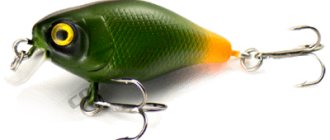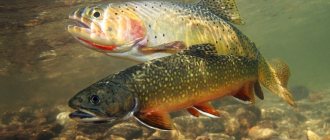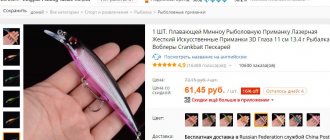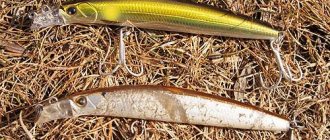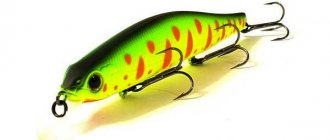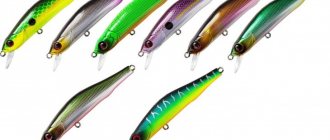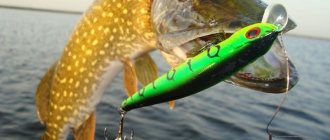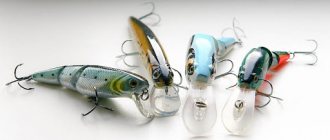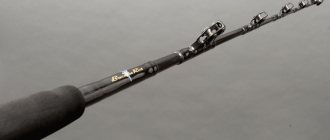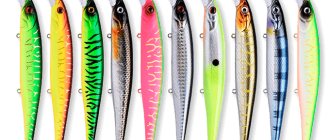Large specimens of pike and pike perch often prefer edges with sharp changes in depth. Large perches live in the bottom area. If the fish are inactive on the surface, it is worth trying hunting in depth.
You can catch fish at depth using jig fishing, but this method does not always help. When moving along the bottom, the jig tackle can be cut off on sharp stones, get stuck in a snag, or in a crevice. Deep wobblers help out. Is it possible to use dips for fishing in the surface layers of a reservoir?
There is no generally accepted unambiguous definition of what a deep wobbler is.
- This is a bait that has a large blade that helps it sink deeper than 1.5 meters.
- This is a deep-sea wobbler for fishing bottom and near-bottom areas.
- Deep often means a wobbler that can go deeper than usual .
Although definitions 2 and 3 are formally correct, they do not reflect the very essence of the dip. They can include any sinking wobbler that can sink to the very bottom of the reservoir. Definition #1 is closer to the truth. It is necessary to clarify that it is precisely due to the presence of a large blade located on the same axis with the fishing line, which has a particular angle of inclination, that the depth and speed of immersion of the wobbler is set.
What is a “wobbler”?
This is a hard bait, most often made of plastic in the shape of a fish. Any wobbler consists of a body, a blade, hooks and a wire loop. Attracts predators because it looks like easy prey. Thanks to a special ball in the bait, it makes an attractive sound for fish. It costs more than silicone baits, but it is important to consider that the wobbler will last much longer. Moreover, in some wiring, the wobbler does not even need to be twitched; its game will do everything itself, unlike silicone baits, which need to be constantly animated. Wobblers are more functional than natural baits. However, now there are a huge number of products on the market and it is very difficult to understand how they differ from each other. That is why we have prepared instructions for choosing wobblers.
Form
Wobblers, based on the shape of their body, are divided into a large number of different types: minnow, shad, crank, fat, etc.
To catch pike, you can use wobblers of any type, they all catch pike, some are better, some are worse, but they catch everything.
You may be interested in: Spoons for pike
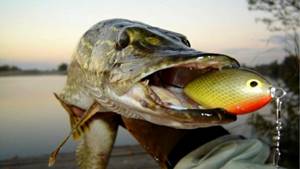
But still, if we talk about one wobbler body shape that provokes a pike to attack much better and faster, then these are minnow wobblers.
The minnow wobbler, with its very shape of its body, somewhat oblong, tapering towards the tail, especially attracts pike. It is minnow class wobblers that can be called pike favorites, real pike killer wobblers.
Following the minnow wobblers are poppers, surface baits that do not have a blade and make characteristic gurgling sounds when retrieved. Under certain conditions, poppers are not only not inferior to minnow wobblers, but can even surpass them in catchability.
Recently, the popularity of bladeless wobblers for pike fishing has greatly increased. This class of baits includes: walkers, gliders, crawlers, rattlins and swimbaits. These classes of lures are more specific and require the angler to have more experience in catching pike, so they are less suitable for beginner spinning anglers.
The main characteristics of wobblers - how to choose based on them?
Wobbler buoyancy
This indicator indicates how the wobbler behaves when it gets into the water. One of the key indicators, since, based on it, it is determined whether the wobbler can be used in certain conditions. For example, floating baits are used in shallow water, and sinking baits are used in deep water. Based on this, three categories can be distinguished:
- Floating
After hitting the water, the wobbler remains on the surface, and when retrieving during pauses, it floats up. Mainly used in shallow water or contaminated areas. They easily overcome obstacles, so they are most effective in such a situation. Plastic is mainly used for production; wood or foam is less common. They are divided into fast-floating (FF), floating (F) and slow-floating (SF). From the name it is clear what their difference is. The choice depends on the activity of the fish. If the fish is inactive, take slow-rising wobblers; if active, take fast-rising ones.
- Suspending
This is a wobbler with neutral buoyancy. They “hang” at the depth stated by the manufacturer. This happens thanks to the air chamber inside the bait, which is filled with weights. They constantly flash in front of the fish and are in its field of vision, thereby attracting it. Best suited for catching pike and pike perch.
- Sinking
Most often used for fishing in deep water or with little vegetation. They are attractive to predators because they imitate dying fish, sinking to the bottom, as they are quite heavy in weight. It is most convenient to use in clean reservoirs, they are also suitable for fast currents, and can be easily cast over long distances. They are divided into slow-sinking (SS), sinking (S) and fast-sinking (FS). If the fish is active, then you should also opt for fast-sinking ones; if not, then slow-sinking models are suitable.
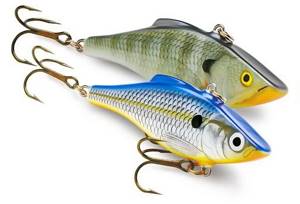
Wobbler length
One of the indicators that affects the performance of a wobbler. Long wobblers have a more sweeping action, while short ones have the opposite effect. There is another dependence: for larger fish they choose a longer wobbler, for small ones, respectively, vice versa.
Wobbler weight
The choice of wobbler weight directly depends on the test of your spinning rod. When making a choice in favor of one or another bait, it is worth assessing whether your rod will allow you to fish with it.
Object of fishing
On our website you can easily apply a filter depending on the object of your fishing. This way you can choose the optimal wobbler for both perch and pike. Also, many manufacturers initially indicate for what fishing a particular wobbler is needed, which greatly simplifies the search for the right bait. For example
- for pike
- for perch
- for zander
- for asp
- for chub
- for trout
- in ide
Wobbler deepening
This factor indicates the depth to which the bait can sink and directly depends on the body of water in which fishing is planned. If you are fishing in a place with shallow depth or in a polluted area, then you should choose a wobbler with a small depth, usually up to 30 cm. If you are fishing in a deep and clean reservoir, then the depth should be large. Surface baits attract fish exclusively at the level of the water table. Usually do not have a shoulder blade. They attract fishermen because they can see the fish attacking the bait. There is also a distinction between deep and medium depth.
Wobbler wiring type
- Uniform wiring is quite catchy. Its advantage is that many predatory fish have this hunting style, so other baits can scare them away. Well used in warm water and strong currents.
- Twitching and jerking are based on horizontal movements of the rod. Most often, minnow wobblers are used in these styles. The game with a wobbler takes place on one level. The most popular type of wiring for all types of wobblers.
- Trolling is a technique that is used only from a boat. In simple terms, the boat moves and pulls the bait along with it - this is the method. Best used on large, deep bodies of water.
- Stop & Go (stop&go) is a technique that consists of intermittent wiring of a wobbler. Cranks, minnows and shads are used. A depth of 1 meter and below is required. Often, for greater efficiency, they are combined with twitching.

- Long casting system
This function is used when fishing from the shore in order to reach a distant point so as not to spook the fish. To do this, the center of gravity is shifted to the tail section and a magnetic system is often used. Minnows are mainly used. Wobblers with a small blade are also suitable. When using wobblers with a magnetic system, the bait in the air does not twist with the cord.
- Noise chamber
A small space is created inside the wobbler into which the balls are placed. This is designed to provide additional sounds that will attract fish.
Wobbler color
When choosing, it is necessary to take into account lighting, climate, water transparency and many other environmental factors. In clear weather, it is best to use bait in light or acidic colors that will match the colors around you. In dark or cloudy weather, it is better to use inconspicuous baits of natural colors. For example, when fishing at great depths, wobblers of natural colors are used.
Nories Laydown minnow MP 110SP
A discontinued wobbler, which is the emer version of the legendary Laydown minnow MID 110 family, which includes three versions - SP, F and HF, which very often not very competent spinning anglers classify as a floating version, although the F and HF versions are very different in ascent speed . He became one of the favorites at the end of the season and in mid-August almost distinguished himself by catching a pike in the region of ten. We were fishing with a partner, I caught three or four shrewnuts with a silver empehu, my partner had zero. We came out of the pool and then the crocodile threw an empehu! Moreover, at first I thought that I was bringing three people to my place, and only when I brought it up did I realize how seriously I had made a mistake in the size. That pike went right under the shore. But this year, empeha still managed to rehabilitate herself with the seven, who grabbed her by the throat. Among the features of the wobbler, I would like to note that it, like the entire family of 110 Laydowns, is not just quiet, but absolutely silent, which is a definite plus on reservoirs crowded with all sorts of rattles. It is non-persistent, despite the seemingly deep blade, and easily allows itself to be animated near the surface. Due to this, it has a very lively game even compared to its relative Nories Laydown minnow MID 110SP, which is a little more stubborn and due to this also loses a little in the liveliness of the game. And finally, I want to say that I was immediately lucky with the color. After leaving an impression, I took out empekha in other colors, including acid mat-tiger (BR-137), but none of them can even visually compare in the game and effect on pike with the silver and reflective color BR-152. Once, in May, BR-137 shot well and this was the only memorable episode of this acid-colored aircraft.
Wobblers were presented by Dmitry (Dimich-Chik)
Life hacks when choosing wobblers
First of all, it is important to know how the models are designated. Depending on the manufacturer, the naming scheme may vary, but most often it looks like model + size + buoyancy + color.
Some of the most attractive colors are acid colors and brindle wobbler color. Because of it, predatory fish begin to get nervous, which increases the chance of successful fishing. However, there are few high-quality colors like these; not all manufacturers make them. When choosing a wobbler, it is also important to consider the region in which you plan to fish.
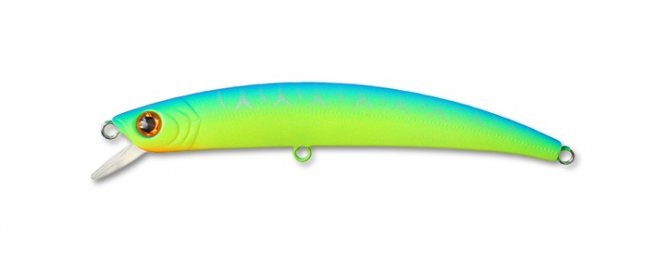
If you want to save money, then there are analogues for any premium models on the market. But it is important to remember that in general the wobbler will look like an expensive one, but any reduction in price comes at the expense of quality, so budget models will be a little worse colored. Expensive models are distinguished by their original design from the manufacturer; the fittings are made of more durable materials.
Having tried a dozen models in practice, you will understand that the specifics of the game are different for everyone. There may even be two wobblers of the same model, but slightly different lengths, and the game will be different. Unfortunately, all these tricks can only be understood when using a wobbler. But, in every store in our chain, the salespeople are so professional that if you show with your hand what effect you need, they will select the perfect wobbler for you 

The reference article is based on the expert opinion of the author
Daiwa Flat Side big minnow 148SF-SP
The wobbler is a one-to-one copy of the legendary diving TD minnow 1091 F/SP and TD 1121F/SP, enlarged to 148 mm. Despite its size, it is relatively non-resistant due to its small blade area, due to which it easily allows itself to be animated not only at a meter depth, but also at the very surface. The game is stunning, if you manage to select the strength of the jerks, the wobbler prowls very widely, while having quite pronounced oscillations of the body. This game does not leave pike indifferent. In August '13, the PPB (Pink Pearl Back) color appeared in the line. The pink back, which is clearly visible during the animation, the white-pearl box and the classic streak-orange belly. In general, I immediately realized that I needed this color and it would work 100%. And it soon appeared and lived up to my expectations! I started catching right away, the maximum pike on this wobbler was 1.8 kg. The following season, the wobbler continued to work, in June it almost caught a pike weighing about 3.5 kg, which unfortunately came off while fishing from a high bank. In the ’15 season, I didn’t use it very actively for the reason that I fished more with its brother, the silver Daiwa Flat Side big minnow 148SF-SP in Polka Dot Nigoi color, which surprised me with its catchability, sometimes outperforming all other Japanese wobblers. But, nevertheless, this season the pink Daiva managed to distinguish herself with 2.7 kg of pike. There are no disadvantages to this model, except for the exorbitant cost compared to conventional Japanese ones, the purchase is problematic even despite the high cost and tees that are rather weak for my conditions, which I am replacing with more powerful ones. The game, the casting horizon, and the casting range are completely satisfactory.
